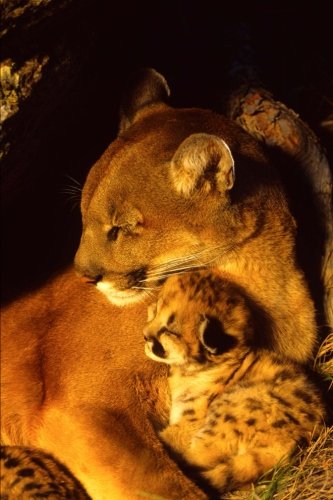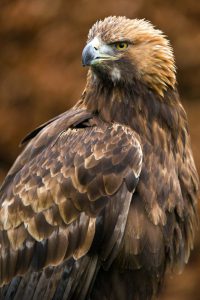Mountain Animals
Category : Soaring Mountains

Mama Mountain Lion and her Baby Kitten in the Den Journal: 150 Page Lined Notebook/Diary
Mountains are home to a rich variety of wildlife. Black bears, mule deer, big horn sheep, and mountain lions are the largest of the mountain’s animals.
The mountain lion (Puma concolor) is also known as the cougar, puma, panther, and catamount, and is the largest wildcat in North America. Mountain lions have powerful limbs and can leap as high as 15 feet and as far as 40 feet.
Mountain lions like to prey on deer, though they also eat smaller animals such as coyotes, porcupines, and raccoons. They usually hunt at night or during the hours of dawn and dusk. These cats employ a blend of stealth and power, stalking their prey until an opportunity arrives to pounce, then going for the back of the neck with a fatal bite. They will hide large carcasses and feed on them for several days.
Mountain lions require a lot of room—only a few cats can survive in a 30-square-mile (78-square-kilometer) range. They are solitary and shy animals, seldom seen by humans.
They are very territorial and actively avoid other cats except during courtship. Their ranges can vary in size from 10 square miles to around 370 square miles; females tend to have smaller ranges than males.
Females have two to four kittens, which the mother raises alone. The kittens nurse for two months, and then start to travel with their mother at which time she teaches them to hunt. They will remain with their mother from 1 ½ – 2 years. Males that enter another male’s territory have been known to kill the kittens so that females will be more willing to mate.
Life is particularly tough for large predators. Apart from the cold, their prey are scarce and quick-footed. The rare snow leopard lives above the snowline in the mountains of central Asia, preying on ibex and tahr.

Snow Leopards: Biodiversity of the World: Conservation from Genes to Landscapes
The snow leopard, known for its beautiful, thick fur, has a white, yellowish or soft gray coat with ringed spots of black on brown. The markings help camouflage it from prey. With their thick coats, heavy fur-lined tails and paws covered with fur, snow leopards are perfectly adapted to the cold and dry habitats in which they live.
Snow leopards are found at altitudes between 9,800 and 17,000 feet in the high, rugged mountains of Central Asia. Their range spans from Afghanistan to Kazakstan and Russia in the north to India and China in the east. China contains about 60% of snow leopard habitat.
Snow leopards prefer to inhabit steep cliff areas, rocky outcrops and ravines. Such habitats provide them with the camouflage they need to ambush unsuspecting prey. They stalk their prey and usually spring from a distance of 20 – 50 feet. Their long and powerful hind limbs help snow leopards leap up to 30 feet, which is six times their body length.
Mostly active at dawn and dusk, snow leopards are rarely seen in the wild. Unlike other big cats, snow leopards are unable to roar. Solitary in nature, they pair only during the breeding season.
Females give birth in rocky dens lined with their fur. The young follow their mother on hunts at three months and remain with her through their first winter.
Snow leopards are top predators in their environment, and their favourite prey are mountain sheep and goats. Without the snow leopard there may be too many of these herbivores, which would overgraze the sparse alpine plants on the mountains, leaving no food for other wildlife.
Any creature that lives in the mountains must be able to cope with changing temperatures. For every 200 meters an animal goes up a mountain, the temperature drops by 1 degree Centigrade.
Many species of hoofed and herbivorous mammal such as goats, deer, sheep and llamas have adapted well to living in the mountains and are often found grazing on ledges and on cliff faces. These herbivores obviously attract large predators to inhabit mountainous regions, such as bears, cougars and mountain lions.
Most large mountain animals migrate. For example, in the Rockies elk and bighorn sheep, which feed on the alpine tundra foliage during the summer, begin to head downward in late fall to avoid the deep snows. They spend the winter below timberline in thick protected areas. As the snows melt in spring they move upward again, following the newly sprouted tender shoots of willow.
Large mountain animals, such as the Rocky Mountain goat, bighorn sheep, and the ibexes of the Alps are all very sure-footed. They each have specially designed hoofs which enable them to travel over really rough rocky terrain at great speeds, and also to traverse steep cliffs without losing their footing.
These hoofs are flexible and also have relatively soft arched bottoms (kinda like your rock-climbing shoes) which give them excellent grip on steep, rocky surfaces.
These animals also have to possess great agility, obviously, to jump and run over such rough ground, and they must develop it very quickly to avoid predators.
Baby bighorn sheep, for example, can stand within an hour of birth. Within a week it can follow its mother wherever she goes, and within two weeks it can run as fast as she can!
Mountain goats are among the most sure-footed of all mountain creatures. They are also very efficient in foraging for plants in areas with very “slim pickin’s.” These goats have four stomachs which allow them to extract the last bits of possible nourishment from their bleak rations. Cold is no problem for this animal; it has a nice woolly undercoat and long shaggy outercoat which works well as a wind breaker.
Small mammals include the coyote, raccoon, bobcat, several types of squirrels, skunk, chipmunks, grey fox and even beavers.
A very small mammal will lose heat so fast through its relatively large skin surface area, that it must stay extremely active and keep its little internal furnace continuously stoked, or it will freeze to death.
For example, the mountain shrew, which is perhaps the smallest mammal at high altitudes, has an extremely high metabolism; its heart beats up to 1200 times a minute, it must eat something at least every hour and must consume its own weight in food every day, or it will die.

Golden Eagle Journal: 150 page lined notebook/diary
There are many species of birds as well.The winds that sweep around mountains make flight hazardous, but mountains are home to some magnificent birds of prey. Golden eagles are the masters of the mountain peaks and valleys, soaring on outstretched wings as they search for small mammals like pikas and marmots to eat.
Red-tail hawks and ravens are often seen soaring on the warm air currents along the slopes of the mountains. The deep blue Stellar’s jays, noisy scrub jays, black crows, many species of woodpeckers, towhees, chickadees, and juncoes also make the mountains their home.
Other aerial experts are scavengers: the Andean condor is a type of vulture that rides the mountain air currents looking for prey. Another vulture, the bearded vulture or lammergeier of Africa and Eurasia, likes to eat the fatty bone marrow of dead animals. It carries the bones high up into the air and drops them to smash open on the rocks below.
Many smaller species of birds are found high up in the mountains. In the Alps, they include Alpine swifts, Alpine choughs and snow finches.
There are also a number of animal species that are not found on the mountains but inside them. Many smaller animal species have adapted to living their lives in the safety of caves and crevices. Caves are popular homes for amphibians such as toads and salamanders, numerous species of insect, and mammals such as bats.
Although the mountains themselves are standing strong, there are numerous threats to the wildlife that inhabits mountain habitats. Deforestation, quarrying and the development of ski-resorts are the most damaging advances to mountain wildlife, along with global warming and climate change which affects the growth of plants at higher altitudes.
If you have any information,questions, or feedback you would like to include in this post.
Please email momo19@naturekingdoms.com or leave your comments below.